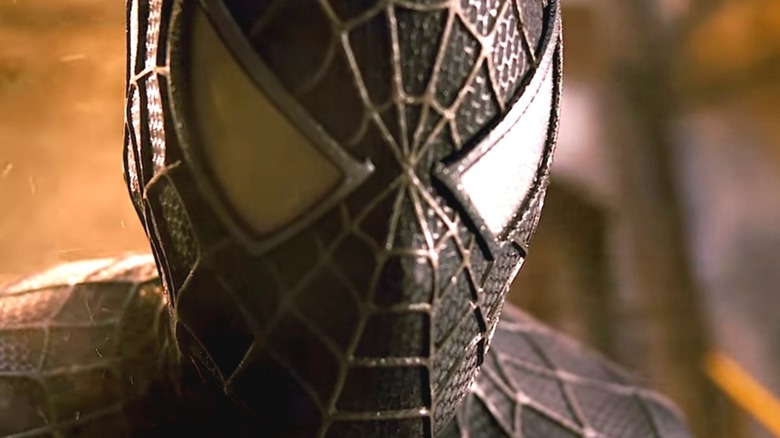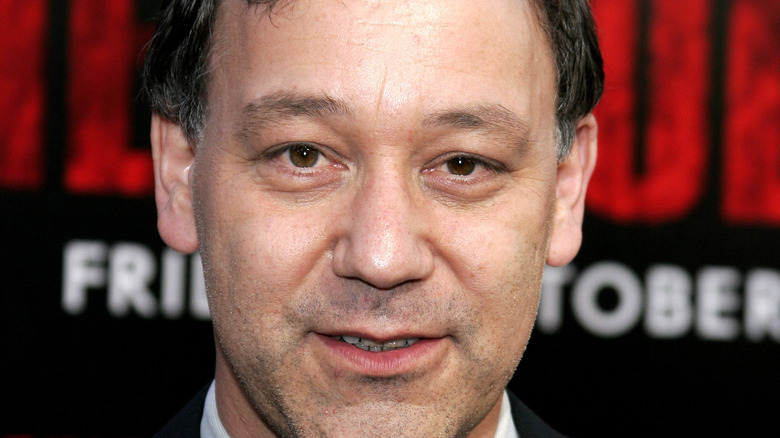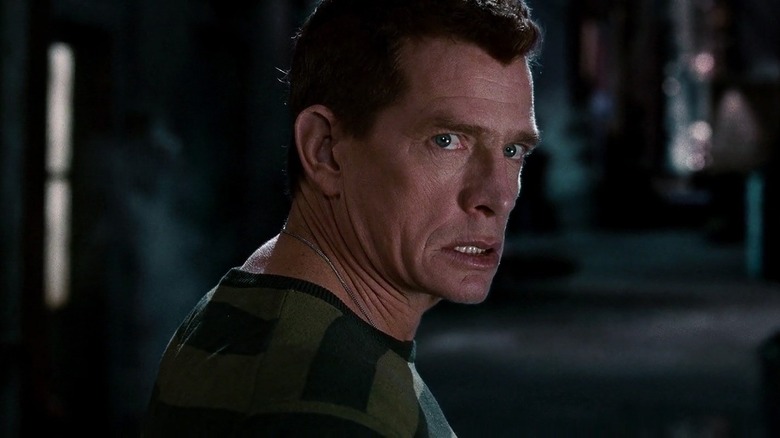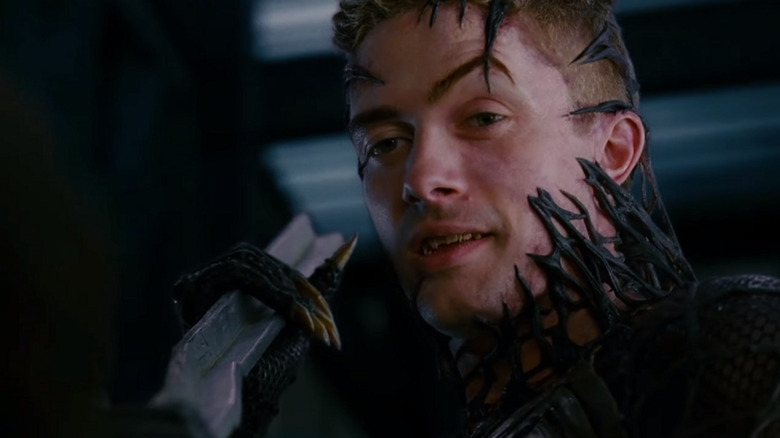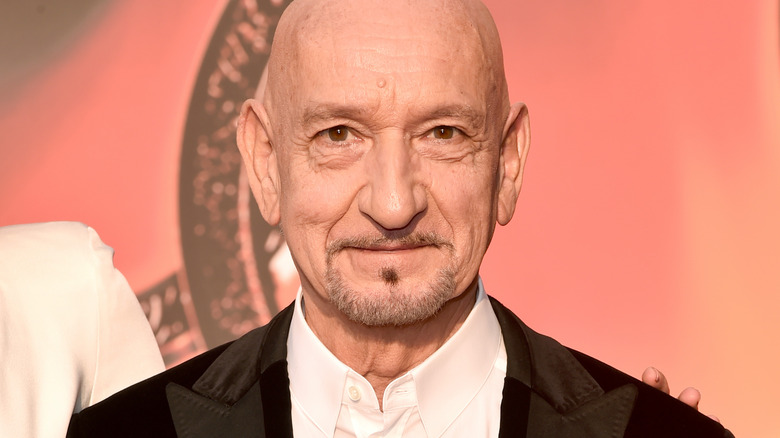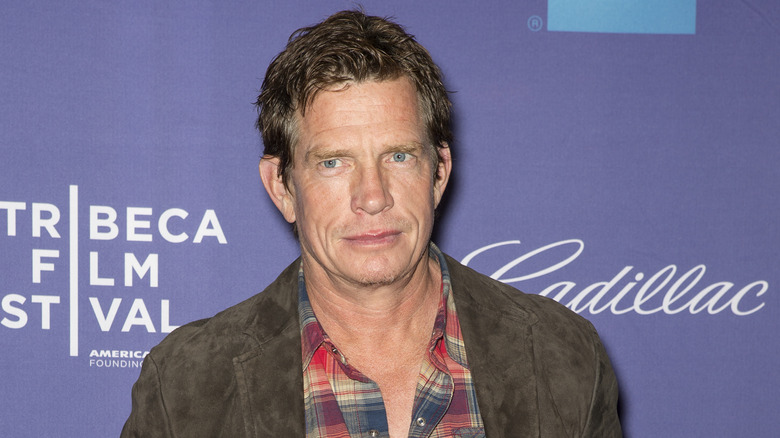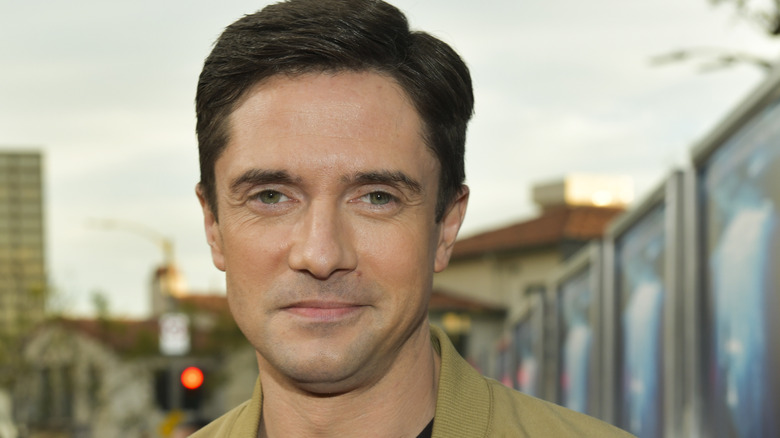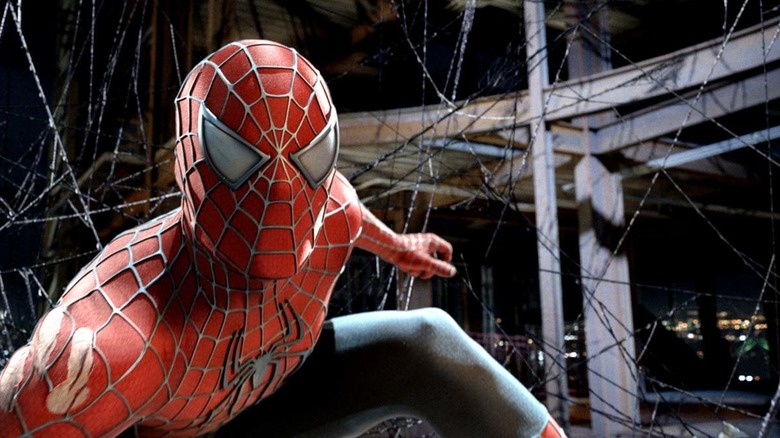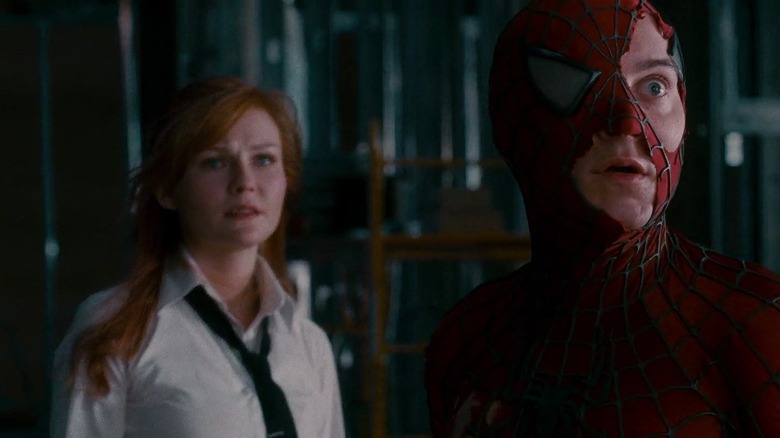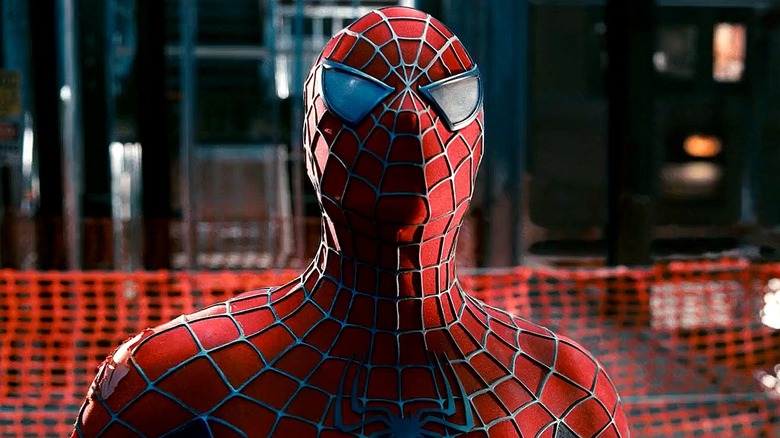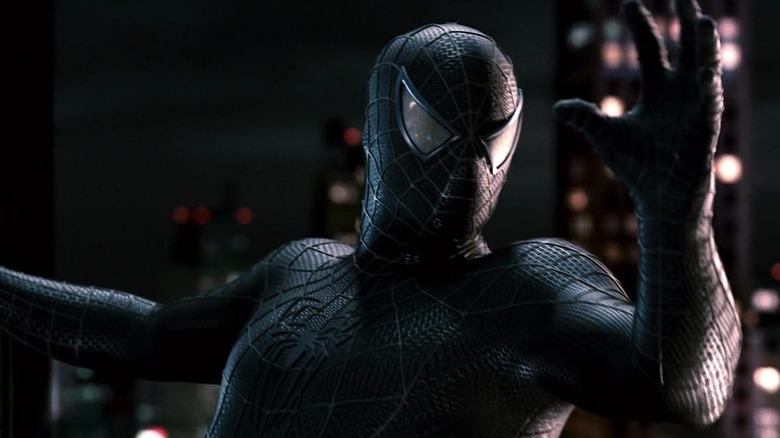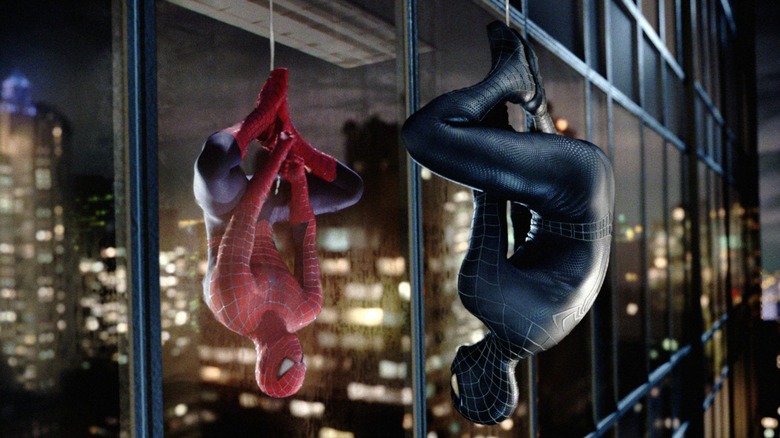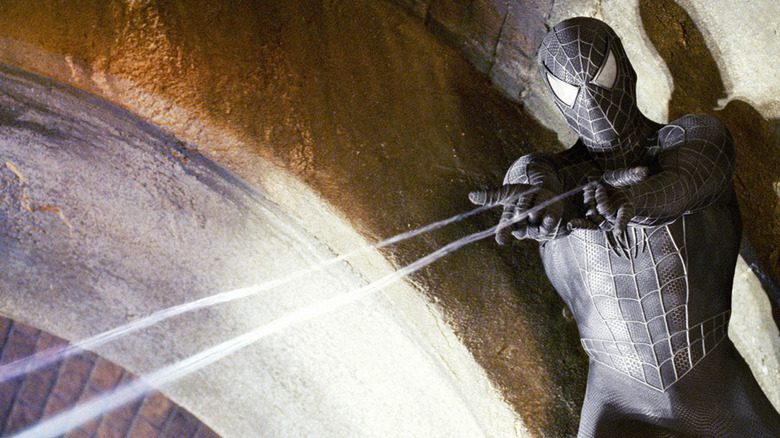The Untold Truth Of Spider-Man 3
"Spider-Man 3" was, for better and for worse, a distinctive entry in the original trilogy of "Spider-Man" installments helmed by Sam Raimi. It had some great performances from the likes of Thomas Haden Church and Kirsten Dunst, while amusing elements like Peter Parker's dorky interpretation of being a rebel were fitting for the character. Unfortunately, it was also a messy feature that ended up losing so many interesting character beats, leading to a finale too full of chaos and hollow spectacle. The result of all those disjointed pieces is a movie that has sparked tons of conversation for years now — though even with all that discourse, there's lots about "Spider-Man 3" that's managed to remain shockingly obscure.
The story of "Spider-Man 3" encompasses a wide array of aspects of this massive project, a reflection of just how audacious and expansive this blockbuster was. These details the factors that led to its gargantuan budget, how Thomas Haden Church got cast as Flint Marko/The Sandman, some tantalizing casting for an abandoned villain, and how key crew members feel about the film years later. Grab your super suit, symbiote-enhanced or otherwise, and prepare to dive deep into the untold truth of "Spider-Man 3."
Sam Raimi's gratitude with getting to work with a familiar crew
No matter how many times you undertake a big blockbuster directorial assignment, it's always going to be a daunting endeavor. These are such big movies with a multitude of moving parts, it's inevitable that they'll be overwhelming to some degree. By the time "Spider-Man 3" rolled around, director Sam Raimi had gotten well-versed in the ins and outs of executing mega-expensive blockbusters, but he too was feeling the squeeze of having to juggle so much on one movie. Luckily, Raimi did have something integral to keep his sanity in the middle of all the high wire demands of "Spider-Man 3" due to his familiarity with the cast and crew.
"The easiest thing [about 'Spider-Man 3'] was that the team was the same," Raimi explained to SuperheroHype. "Not just the producers who I became very familiar with, but I had the same production designer, the editor was the same, the animators were the same." This extended to the cast of "Spider-Man 3," with whom Raimi had developed a close bond. Enough trust had developed between this filmmaker and franchise acting staples like Tobey Maguire that they could be frank with each other on the set, which allowed for real creativity to blossom. That was the kind of rapport and exciting filmmaking that could only exist when you've worked with a creative team for as long as Raimi had the artists behind this original "Spider-Man" trilogy.
The greater subtext to the Spider-Man 3 villains
Part of what's made the Sam Raimi "Spider-Man" movies endure like they have is their approach to the villains. Not only are they realized through detailed performances courtesy of strong actors, but they also tend to be nuanced characters that are more tragic than pure distilled nefariousness. Adding these shades of grey made figures like The Green Goblin and Doctor Octopus all the more compelling and gave performers like Willem Dafoe or Alfred Molina so much to work with. Heading into "Spider-Man 3," Sam Raimi was eager to continue this trend by bringing to life villains who could function as distillations of the movie's principal themes.
Talking to SuperheroHype, Raimi explained that "Spider-Man 3" intended to introduce some moral ambiguity into the life of Spider-Man, with the goal to of teaching him that it's more important to work towards forgiveness than enact vengeance. This is where the movies version of Sandman came in, with the character being rewritten as Uncle Ben's killer. This was done to ensure that Peter Parker would have to deal with wanting personal vengeance over the runtime of "Spider-Man 3." Having the Spider-Man/Sandman dynamic build towards the superhero learning the power of forgiveness ensured that, like past foes in this series, "Spider-Man 3" could cover some weightier themes.
Why Venom was brought into Spider-Man 3
Venom was a very odd choice to be a villain in a Sam Raimi "Spider-Man" movie. The franchise, before "Spider-Man 3," had largely involved baddies from vintage 1960s Spider-Man comics, the kind that director Sam Raimi had grown up reading. Venom, meanwhile, was somebody who was introduced into the broader Spider-Man mythology in the 1990s, decades into the character's run. He was emblematic of edginess and other trends in comic books from that era, a sharp contrast to the endearingly old-fashioned sensibilities of Doctor Octopus and the Green Goblin or even fellow "Spider-Man 3" adversary Sandman.
In talking to SuperheroHype, Sam Raimi revealed that Venom, unsurprisingly, was not a character he was chomping at the bit to introduce. Instead, producer Avi Arad told Raimi that he had to include villains in the "Spider-Man" movies that fans wanted to see rather than focusing exclusively on foes that Raimi was super beholden to. After this conversation, Raimi decided to put Venom into "Spider-Man 3" per Arad's instructions. From there, Raimi began to learn more and more about Venom and eventually found a way to work him into the narrative as a way of reflecting the horrors of vengeance. Despite Raimi trying his best to work him into the film to please fans, Venom's eventual presence in the film would prove controversial, and Arad himself would express regret over forcing the character into the feature.
Ben Kingsley was supposed to play The Vulture
In 2017, one of Spider-Man's greatest comic book foes would finally get to come to the big screen thanks to "Spider-Man: Homecoming." In this feature, Michael Keaton played Adrian Toomes/The Vulture, who proves to be a formidable foe both in his winged mechanical suit and as the dad to Peter Parker's prom date. Given how prolific The Vulture is in the comics, it can be shocking to consider just how long it took for him to appear in a major superhero movie. However, director Sam Raimi did try to get him to the big screen earlier by making him one of the antagonists of "Spider-Man 3."
Vulture stuck around long enough as a prominent part of this feature to even get a cast member attached to play him, with Oscar-winner Ben Kingsley once connected to the role. Despite both the fun casting of the character and how well he would have fit into the film's narrative, Vulture would eventually get axed from "Spider-Man 3." At the insistence of the film's producers, Venom was added to "Spider-Man 3," leaving no room for winged criminal. With Vulture no longer a part of this production, it would take until "Spider-Man: Homecoming" a decade later for the supervillain to get properly realized on the silver screen.
How Thomas Haden Church got cast in Spider-Man 3
In his career as an actor, Thomas Haden Church has gone anywhere and everywhere. One minute he's the goofy adversary of Brendan Fraser's "George of the Jungle," the next minute he's scoring universal acclaim for his work in "Sideways." Playing characters both big and small, Church has developed a reputation for being a versatile actor. This made it no surprise to see him taking on the part of a supervillain in "Spider-Man 3," especially since he was fresh off his buzzy turn in "Sideways." In fact, it was that Alexander Payne movie that led to him securing a role in a feature as massive as "Spider-Man 3."
Talking to SuperheroHype, Raimi revealed that the day after Church scored an award for his "Sideways" performance, he was called in to talk about a role in "Spider-Man 3." There wasn't a screenplay for the project at that point, but Sam Raimi and company had already fleshed out the idea of who Sandman would be and pitched those concepts to Church. The actor also noted that his prior relationship with Raimi also helped him get the role, as Raimi had been eager to cast Church in a pivotal role in his 2000 movie "The Gift." Though that casting didn't work out, Raimi would get to work with Thomas Haden Church in a much higher-profile capacity once "Spider-Man 3" rolled around.
How Topher Grace perceives Eddie Brock as a parallel to Peter Parker
Venom has been able to further cement himself as somebody who can work without Spider-Man, thanks to a series of solo films anchored by Tom Hardy. Now when people think of Venom, they don't picture this character tangling with Spider-Man, they just envision Tom Hardy jumping into a lobster tank in a frantic panic. But back when "Spider-Man 3" was first getting off the ground, both Venom and his alter-ego Eddie Brock were being executed as characters whose entire beings would be informed by their relationship with Spider-Man.
Speaking at the 2006 San Diego Comic-Con (via IGN), Eddie Brock/Venom actor Topher Grace noted that he based his performance on the idea of how similar this incarnation of Brock was to Peter Parker. While the two figures had overlapping personality traits and a shared occupation, Grace molded his performance around the idea that this character experienced a traumatic childhood. This inspired an edge of darkness in Brock that would inform his transformation into Venom.
The brief plans to split Spider-Man 3 into two movies
There's a lot going on in "Spider-Man 3." Between a trio of villains, the introduction of Gwen Stacy, and the various problems in the romantic life of Peter Parker and Mary Jane Watson, there's so much to juggle in a single superhero blockbuster. Even the people behind "Spider-Man 3" seemed to realize this since there were plans at one point to split this feature across two movies. Though an unprecedented idea for live-action "Spider-Man" films, this would have been par for the course for blockbuster sequels in the 2000s. The "Lord of the Rings" titles had normalized filming multiple big-budget features back-to-back and franchises like "The Matrix" and "Pirates of the Caribbean" had followed the example of this epic saga by shooting multiple follow-ups at once.
With this trend becoming such a norm, it wouldn't have been a shock to see "Spider-Man 3" unfurl across multiple films. However, per Entertainment Weekly, the screenwriters of "Spider-Man 3" abandoned this enticing concept for one reason: they could never conjure up a proper way to close out the first part. It's easy to imagine a scenario where moviegoers, frustrated with an unsatisfactory finale for the first part, outright refused to even entertain the notion of watching the second part of "Spider-Man 3." Thus, this installment remained a solitary movie, though that may not have been the wisest decision, given that the overstuffed nature of the final cut of "Spider-Man 3" drew heavy criticism.
Costly visual effects were largely responsible for the big budget
None of the preceding "Spider-Man" movies were cheap indies in terms of their respective budgets, but "Spider-Man" and "Spider-Man 2" had nowhere near the kind of massive price tag that came attached to "Spider-Man 3." The $140 million cost of "Spider-Man" in 2002 looked practically meager compared to the massive $258 million budget of "Spider-Man 3." It can be hard to wrap one's brain around a budget of that size. It can also be difficult to comprehend just what exactly happened in this movie that could justify costs so high.
Talking to Rotten Tomatoes, producer Laura Ziskin dished on what led to such a sizeable budgetary increase for "Spider-Man 3." She explained that everyone involved in the movie, including director Sam Raimi, were determined to deliver something even bigger than "Spider-Man 2" to the general public. The desire to produce something unprecedented in its scope necessitated a much larger visual effects budget, especially for realizing the finer intricacies of the Sandman character. She also pointed out that, during principal photography, the budget for "Spider-Man 3" remained consistent with the budget of "Spider-Man 2." It was only during post-production processes like creating the visual effects that the costs for this production began to climb so high. Even knowing the circumstances that informed this budget, though, it can still be hard to properly comprehend the $258 million costs of "Spider-Man 3."
Why a new composer was brought on for Spider-Man 3
For "Spider-Man 3," many of the cast and crew members of the original two "Spider-Man" movies were back to deliver another big web-crawler adventure. A massive exception to this, though, was composer Danny Elfman. Though he'd provided the score for the preceding "Spider-Man" installments and several other Sam Raimi directorial efforts, he was MIA for "Spider-Man 3." The reasoning behind his absence was no secret, as Elfman (per IndieWire) had been public about his various creative disagreements with Raimi on "Spider-Man 2." After that production went so sour, Elfman vowed never to work with the "Evil Dead" director ever again.
With Elfman out, it was time for somebody new to hop onto "Spider-Man 3" and deliver a score. Christopher Young, who previously delivered additional music for "Spider-Man 2," would end up being the successor to Elfman. Eventually, Raimi and Elfman would repair their relationship and would further collaborate on projects like "Doctor Strange and the Multiverse of Madness." Young didn't get left in the dust after his "Spider-Man 3" work, though, with this composer reuniting with Raimi to provide the score the Quibi TV show "50 States of Fright," on which Raimi served as an executive producer and director.
The lengthy marketing campaign for Spider-Man 3
Hot off the first two incredibly lucrative installments in the "Spider-Man" saga, the marketing for "Spider-Man 3" didn't have to do much to convince moviegoers to give this feature a shot. All the promotional material had to do was just tell people what day this motion picture was coming out and people would inevitably turn out in droves to see it. However, even with that being the case, Sony/Columbia opted to give the film a massive marketing push so expansive in scale that it stretched out nearly an entire year before the movie even came out. "Spider-Man 3," scheduled for release in May 2007, dropped a teaser trailer in June 2006 on screenings of "Superman Returns."
One of the big superhero films of the summer, it made total sense to launch the "Spider-Man 3" ad campaign on "Superman Returns." Though the teaser didn't offer much for audiences to chew on, it still made it apparent that a new "Spider-Man" movie was arriving on May 4, 2007. After that, the studio refused to ease up on the marketing as a barrage of further trailers, commercials, and product tie-ins would emerge in the next 10 months to signal the impending arrival of "Spider-Man 3." Even with people already in the bag for more of Tobey Maguire's take on the web-crawler, Sony/Columbia delivered a ceaseless marketing campaign for "Spider-Man 3."
The box office achievements of Spider-Man 3
In 2002, the first live-action "Spider-Man" became the first movie in the history of cinema to gross over $100 million in its first three days of release in North America. "Spider-Man 3" would make its predecessor proud with its own assortment of massive box office achievements, starting with its domestic opening weekend gross. Accumulating $151 million in its first three days in this territory, "Spider-Man 3" was the first title ever to exceed $150 million in that timeframe domestically. Meanwhile, this was also the biggest domestic opening weekend in history, surpassing the $136 million bow of "Pirates of the Caribbean: Dead Man's Chest" for the honor.
The good financial times didn't stop there, as "Spider-Man 3" managed to gross an astonishing $553.3 million internationally for an $894.8 million worldwide haul. This massive sum was enough to make it the biggest "Spider-Man" movie ever globally at the time and improved 8% on the worldwide haul of the original "Spider-Man" from 2002. A downside to its box office run is that it proved frontloaded in North America, where it topped out at $336.5 million. While that's still a large haul, it was the smallest domestic gross for a "Spider-Man" movie at that point, though not by a massive margin. Still, in nearly every respect, "Spider-Man 3" was a colossal financial achievement, a box office titan big enough to top all other features in North America in 2007.
Retrospective feelings about Spider-Man 3 from its crew members
In the years since "Spider-Man 3" came out, fans have often disparaged the movie for a wide array of flaws, including its messy storytelling and a perceived mishandling of Venom. Even the people involved here have often expressed regret over how the final product turned out. Sam Raimi, for one, said as early as 2014 that he wasn't a fan of his work on "Spider-Man 3." Years later, he would note that his bad experience on this blockbuster made him wary of going near other superhero or big-budget properties until "Doctor Strange in the Multiverse of Madness" appeared.
Meanwhile, producer Avi Arad came clean in 2018 about his regrets with "Spider-Man 3," including him forcing Raimi to put Venom into the story. Talking to ScreenRant, Arad revealed that "Spider-Man 3" not only taught him that Venom couldn't be relegated to just a supporting player, but that it's also unwise to force filmmakers to work with characters they just aren't passionate about. It's good that key creative personnel like Arad were able to walk away from "Spider-Man 3" with some valuable life lessons considering some bad movies only leave their cast and crew members with only bad memories. However, Arad's takeaways still don't change the divisive nature of the final product that alienated moviegoers and Raimi alike.
